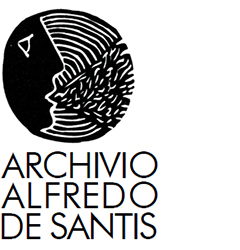SLINGSHOT DAYS – Aldo Colonetti
Alfredo de Santis presents a story, “Slingshot days” through which the sign, transforming itself materially and spatially, communicates different events and adapts to different information strategies, where the only common element is an image that has no history. He has no history, because his story develops outside the traditional professional contexts: here, in fact, the images that reconstruct the history of the sling are presented. The sling here is an excuse, it’s a shape, it’s not a symbol; but its geometric structure allows the most varied uses. Alfredo de Santis researches as graphic and painter, the semantic potential of this tool, without getting lost in a sensation that is either exclusively decorative or strictly functional to the client. It is as if the design culture of de Santis, once set in motion around an idea, an intuition, stubbornly pursues a goal that is always beyond: graphics as a research for new communicative potential. This is the demonstration that a story can always be built, even around an idea or hypothesis that is still imprecise and poorly defined in its semantic comparisons; fundamental is the organization of the signs, their relationship with the text, the control of the parts. Consequently, the designer's culture becomes essential: the slingshot can be transformed into an image for the TV comparison, an international show of the serial; in a chromatic sequence for a calendar; or it can illustrate, changing the background and making it interact with other more or less allusive elements, a cover of Rinascita magazine, on the occasion of a debate on Chernobyl.
At the same time, de Santis re-elaborates, separating it from the more strictly functionalist-graphic context, the sling idea-form; and here, then, the oils on wood and papier-mâché, wood and plaster, oil colours on wood and plaster. These are works intended for a different audience than that of a traditional graphic communication, but above all, aimed at research, all within a poetic where, this time yes, the symbolism and the careful use of some materials go beyond a narrow and sometimes cold need of a more traditionally professional type. Also this type of research is part of the culture of the project, but beware: not all those who have a double disciplinary training, graphic and pictorial, are then able to synthesize this accumulation of experiences, in a clear image where the ambiguity of the sign is under the control, even if partial, of reason. Alfredo de Santis is a designer who knows the limits of the two disciplines, so he uses their potential, without ever completely breaking through the boundaries of both: this quality is called professionalism which also means resign the ease of a hand and an artistic tradition, to highlight, instead, the ethical-political need for linguistic clarity and simplicity.

